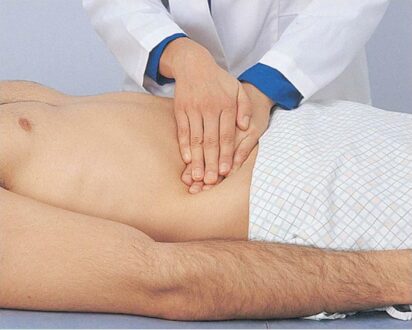Learn all about bimanual palpation of kidney, spleen, liver and parotid gland.
Bimanual palpation of kidneys is done to observe for enlargement or any stones in kidney. First, attempt to capture the kidney between the two hands. If this is not possible, ballot the kidney; flex the fingers of the posterior hand at the metacarpophalangeal joints in the renal angle so that the abdominal contents are pushed anteriorly. The kidney should then float upwards and strike the anterior hand.
An enlarged spleen is not normal and occurs because of another underlying disease. As it enlarges, the spleen grows from the left upper quadrant of the abdomen towards the umbilicus (the belly button). Sometimes the doctor will ask the patient to roll on their right side to better attempt to feel the spleen. An enlarged spleen may not be felt in obese patients.
The purpose of liver palpation is to approximate liver size, feel for tenderness and masses. Keep in mind that many of the findings of liver disease are found outside the abdomen. The normal liver is smooth, with no irregularities. When the liver can be felt, it is usually due to: increased diaphragmatic descent; presence of a palpable caudate or Riedel’s lobe; presence of emphysema with an associated depressed diaphragm; thin body habitus with narrow thoracic cage; fatty infiltration (enlarged with rounded edge); active hepatitis (enlarged and tender); cirrhosis (enlarged with nodular irregularity); or hepatic neoplasm (enlarged with rock-hard or nodular consistency.
The parotid duct opens opposite the crown of the second upper molar tooth.
What is Bimanual Palpation?
The act of feeling with the hand, the application of the fingers with light pressure to the surface of the body for the purpose of determining the condition of the parts beneath in physical diagnosis.
Bimanual Palpation of Kidney
To palpate or ballot the kidneys the examiner should place one hand under the patient in the flank region and the other hand on top just below the borders of the costal margin. In an adult, the kidneys are not usually palpable, except occasionally for the inferior pole of the right kidney. The left kidney is rarely palpable. An easily palpable or tender kidney is abnormal. However, the right kidney is frequently palpable in very thin patients and children. Keep your anterior hand steady in the deep palpation position in the right upper quadrant lateral and parallel to rectus muscle. Attempt to ballot the kidney with the other hand in costophrenic angle. An enlarged kidney should be palpable by the anterior hand. Repeat the same maneuver for the left kidney.
Bimanual Palpation of Spleen
The bimanual spleen technique is used also to palpate the spleen. Symptoms you may experience with an enlarged spleen include: pressure or pain in the left upper part of your abdomen (near the stomach), feeling full without eating a large meal, or pain your left shoulder blade or shoulder area when taking a deep breath. The spleen is generally not palpable in healthy adults. A pathologically enlarged spleen is palpated under the left costal margin during inspiration as the inferior edge descends to the examiner’s fingertips. If an enlarged spleen is already suspected, palpation should begin further down.
Bimanual Palpation of Liver
The normal liver may be slightly tender. Greater tenderness suggests inflammation (e.g. hepatitis) or congestion (e.g. congestive heart disease). Firm, bluntness/rounding or irregularity of liver edge suggests an abnormality. Obstructed, distended gallbladder may be palpable on the inferior liver edge. Nodules may be palpable; rock hard and umbilicated (central dimple) nodules suggest malignancy. You should try to palpate liver by superficial palpation and not deep palpation. Liver edge is just hugging anterior abdominal wall.
With superficial palpation, let the liver edge come and touch your fingers with deep breathing rather than you going after liver. Place your right hand on the patient’s abdomen in the right lower quadrant just lateral to the rectus abdominis, well below lower border of liver dullness. Gently move up to the right upper quadrant lateral to the rectus muscle. Gently pressing in and up ask the patient to take a deep breath. If the liver is enlarged, it will come downward to meet your fingertips and will be recognizable.
Bimanual Palpation of Parotid Gland
The parotid gland is palpated mainly externally but also bimanually around the anterior border of the ramus of the mandible. The gland extends below and behind the angle of the jaw and parotid lumps in this region may be difficult to differentiate from lymph nodes or submandibular gland enlargement. Abscess formation is less common, and is in children or debilitated adults.
 Health & Care Information
Health & Care Information 


